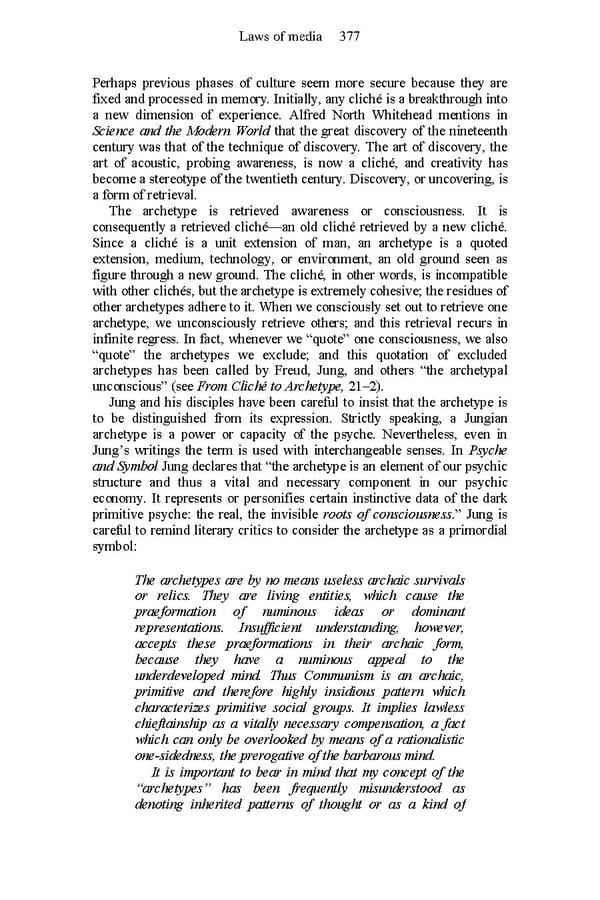Laws of media 377 Perhaps previous phases of culture seem more secure because they are fixed and processed in memory. Initially, any cliché is a breakthrough into a new dimension of experience. Alfred North Whitehead mentions in Science and the Modern World that the great discovery of the nineteenth century was that of the technique of discovery. The art of discovery, the art of acoustic, probing awareness, is now a cliché, and creativity has become a stereotype of the twentieth century. Discovery, or uncovering, is a form of retrieval. The archetype is retrieved awareness or consciousness. It is consequently a retrieved cliché—an old cliché retrieved by a new cliché. Since a cliché is a unit extension of man, an archetype is a quoted extension, medium, technology, or environment, an old ground seen as figure through a new ground. The cliché, in other words, is incompatible with other clichés, but the archetype is extremely cohesive; the residues of other archetypes adhere to it. When we consciously set out to retrieve one archetype, we unconsciously retrieve others; and this retrieval recurs in infinite regress. In fact, whenever we “quote” one consciousness, we also “quote” the archetypes we exclude; and this quotation of excluded archetypes has been called by Freud, Jung, and others “the archetypal unconscious” (see From Cliché to Archetype, 21–2). Jung and his disciples have been careful to insist that the archetype is to be distinguished from its expression. Strictly speaking, a Jungian archetype is a power or capacity of the psyche. Nevertheless, even in Jung’s writings the term is used with interchangeable senses. In Psyche and Symbol Jung declares that “the archetype is an element of our psychic structure and thus a vital and necessary component in our psychic economy. It represents or personifies certain instinctive data of the dark primitive psyche: the real, the invisible roots of consciousness.” Jung is careful to remind literary critics to consider the archetype as a primordial symbol: The archetypes are by no means useless archaic survivals or relics. They are living entities, which cause the praeformation of numinous ideas or dominant representations. Insufficient understanding, however, accepts these praeformations in their archaic form, because they have a numinous appeal to the underdeveloped mind. Thus Communism is an archaic, primitive and therefore highly insidious pattern which characterizes primitive social groups. It implies lawless chieftainship as a vitally necessary compensation, a fact which can only be overlooked by means of a rationalistic one-sidedness, the prerogative of the barbarous mind. It is important to bear in mind that my concept of the “archetypes” has been frequently misunderstood as denoting inherited patterns of thought or as a kind of
 Essential McLuhan Page 383 Page 385
Essential McLuhan Page 383 Page 385